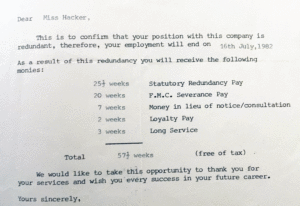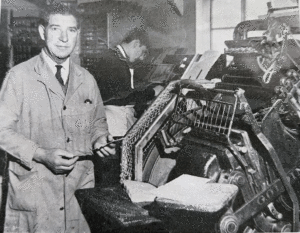The text of the Illustrated History of C&T Harris (Calne) Ltd. is finished but I am still editing it – ‘tinkering ‘ I call it. Moving sections around, deleting bits, putting the bits back, and so on. I am on my fifth version, and I have to lose 1000 words and I still keep finding new material.

One example, was finding an album of Gazette & Herald cuttings from 1982 – the closure of Harris, which I hadn’t seen before. It was gifted by Miss B J Hacker to the Heritage Centre. She worked at Harris and was made redundant 14 May 1982. I don’t know her job as the letter doesn’t mention what department she was in.

The cuttings are useful as they give a wider perspective of the reasons for the closure – and what part FMC played in its failure. Chippenham MP, Richard Needham, didn’t mince his words – ‘indifferent management which had constantly changed and inadequate capital investment as the main reason for closure.’ One example, I have managed to squeeze in, was also backed up by someone involved at the time.
I read that the old slaughterhouses in The Pippin had been upgraded in 1980, at a cost of £400,000, much of which came from EEC funding – only for forty slaughtermen to be sacked shortly after and the slaughterhouses never used.
I talked to builder, Ken Hulbert, who worked on the project. He found the place to be in a terrible state, parts of it so old, it must have been from the original buildings, way back in the 1900s – if not earlier. He knew then that Harris would not survive. I’d love to write more about it but it’ll just be a couple of lines, I’m afraid.
The text is only 15,000 words with a 10% leeway i.e. +500 words. My acknowledgements and bibliography are 460 words already! I’ve got 150 images with captions of 20-40 words = another 6,000 words – still a work in progress. I need more information about some of the pictures. People who worked in the Printing Department have been very helpful with pictures of past workers at their machines.

I wish I had 50,000 words instead of 15,000 (although I’m not sure I have the stamina or knowledge to write that length) to do justice to the subject. It’s obviously a pared down history of the 250 years of Harris in Calne, so every word counts. And every picture tells a story.
NB Amberley Publishing has a lot of catching up to do with its list of books awaiting publication due to the effect of lockdown. The deadline for submission for my book is 31 March when it will join the backlog of books waiting to be edited and the layout and design work to be done. It may not see the light of day until well into 2021.

